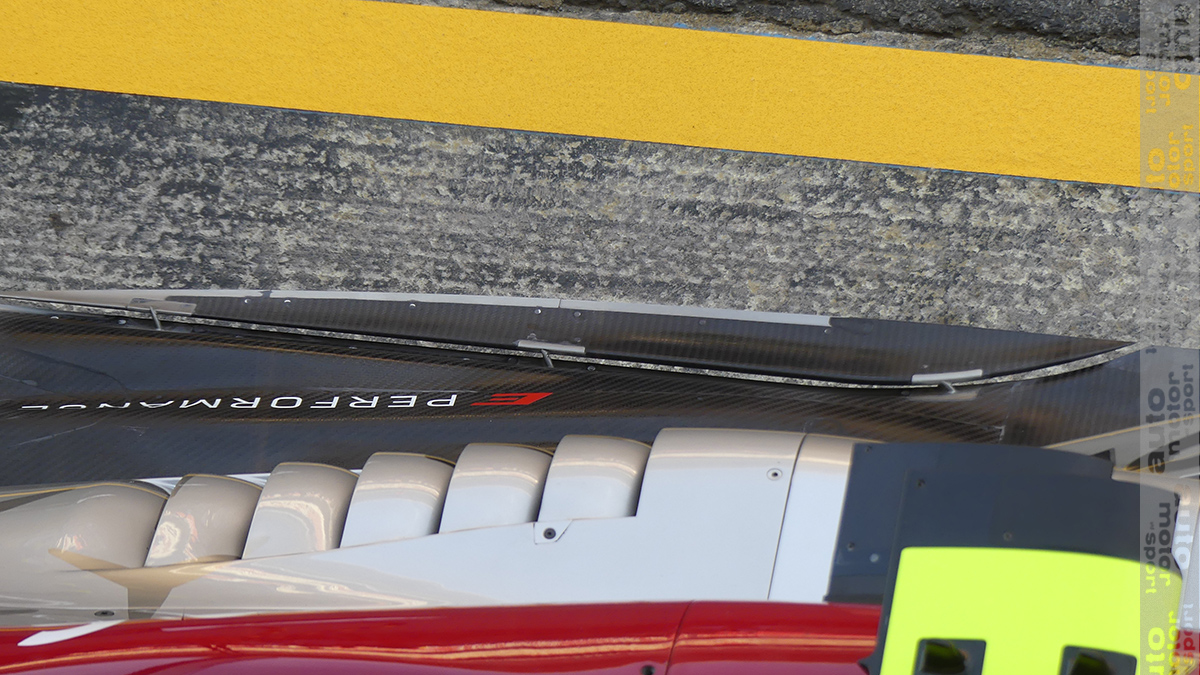
The floor top cover has become taller, and i think there are hidden stays like this



I suggested that this would be possible the other day, it maintains their concept while reducing some of the negatives of how they achieve it. You would have to be very disappointed in your concept to throw it away after 5 races.siskue2005 wrote: ↑20 May 2022, 15:23there are interesting floor changes in that merc... are they running hidden stays like redbull?
https://serving.photos.photobox.com/941 ... 422d2a.jpg
The floor top cover has become taller, and i think there are hidden stays like this
https://serving.photos.photobox.com/058 ... 5d392e.jpg
The new floor with the double T Tray have fixed much of the bouncing at high speed.

it flexes upwards when it hit the track, hence preventing porpoisingKeiKo403 wrote: ↑20 May 2022, 19:33https://pbs.twimg.com/media/FTIs9elaIAA ... ame=medium
Could this part flex down and act like a skirt sealing a section of the floor? We’ve been thinking for a while that floors flexing were a bad thing but could Merc be gaining a benefit from it here?
If it wasn’t going to flex downwards and make contact with the surface of track then why make so much of the edge out of a metallic material and not go full carbon? Unless it’s because they don’t want it to flex?
To pick this up again - here's a side view comparison, i marked certain visual cues (including a line along the screws which connect the engine cover to the floor as they are easy to make out even in this rather low res image) on the new car in a new layer and then added and scaled the old car to fit themAeroDynamic wrote: ↑20 May 2022, 12:29You can notice what RZS is talking about in this shot a little bit as well. Its been re-profiled and may be evidence that the Venturi tunnels are bigger in that area. It's at the very least suggestive of the underfloor being developed and changed.
To point this out directly again, the floor has a steeper slope that meets the body of the car towards the bulge point behind the zero pod. (Right above where the 'e-perfomance' logo used to be in the previous floor spec)

Ahhh makes sense…sometimes I overlook the most obvious stuffsiskue2005 wrote: ↑20 May 2022, 19:51it flexes upwards when it hit the track, hence preventing porpoisingKeiKo403 wrote: ↑20 May 2022, 19:33https://pbs.twimg.com/media/FTIs9elaIAA ... ame=medium
Could this part flex down and act like a skirt sealing a section of the floor? We’ve been thinking for a while that floors flexing were a bad thing but could Merc be gaining a benefit from it here?
If it wasn’t going to flex downwards and make contact with the surface of track then why make so much of the edge out of a metallic material and not go full carbon? Unless it’s because they don’t want it to flex?
Metal connections aren't meant to flex. By the looks of it, its main purpose is seal the floor with the vortexes created by the little wingtips in front of it in conjunction with the floor vanes that go to the sides, acting as a breather and pushing the air downward to prevent scratching. It's an inverted wing pointing 25 degrees inward.siskue2005 wrote: ↑20 May 2022, 19:51it flexes upwards when it hit the track, hence preventing porpoisingKeiKo403 wrote: ↑20 May 2022, 19:33https://pbs.twimg.com/media/FTIs9elaIAA ... ame=medium
Could this part flex down and act like a skirt sealing a section of the floor? We’ve been thinking for a while that floors flexing were a bad thing but could Merc be gaining a benefit from it here?
If it wasn’t going to flex downwards and make contact with the surface of track then why make so much of the edge out of a metallic material and not go full carbon? Unless it’s because they don’t want it to flex?

VacuousFlamboyant wrote: ↑20 May 2022, 20:54Metal connections aren't meant to flex. By the looks of it, its main purpose is seal the floor with the vortexes created by the little wingtips in front of it in conjunction with the floor vanes that go to the sides, acting as a breather and pushing the air downward to prevent scratching. It's an inverted wing pointing 25 degrees inward.siskue2005 wrote: ↑20 May 2022, 19:51it flexes upwards when it hit the track, hence preventing porpoisingKeiKo403 wrote: ↑20 May 2022, 19:33https://pbs.twimg.com/media/FTIs9elaIAA ... ame=medium
Could this part flex down and act like a skirt sealing a section of the floor? We’ve been thinking for a while that floors flexing were a bad thing but could Merc be gaining a benefit from it here?
If it wasn’t going to flex downwards and make contact with the surface of track then why make so much of the edge out of a metallic material and not go full carbon? Unless it’s because they don’t want it to flex?

Carbon fiber in itself is very strong, but composites rely heavily on the fiber arrangement. That's a small piece. Fiber would be better suited if they wanted it to flex as metal tears apart after bending much sooner than carbon fiber. it has roughtly 2x the tensile strength for the same elasticity.PlatinumZealot wrote: ↑20 May 2022, 21:06How do mean metal connections aren't meant to flex?
They use metal there because it flexes more predictibly and repeatadly without cracking.
Notice its only three connections and very thin too. So You can bet that when the winglet hits the track it deflects upward without bending the rest of the floor with it (which you dont want).

Metal is better for fatigue loading and impact. That's why you see the wing "fences" are metal. Carbon reinforced plastic can crack if a fibre is damaged. Near the floor where you have stones, and chips and all that hitting it, you don't wanna use a carbon peice so small to hold up a flap. It will break off.VacuousFlamboyant wrote: ↑20 May 2022, 21:26Carbon fiber in itself is very strong, but composites rely heavily on the fiber arrangement. That's a small piece. Fiber would be better suited if they wanted it to flex as metal tears apart after bending much sooner than carbon fiber. it has roughtly 2x the tensile strength for the same elasticity.PlatinumZealot wrote: ↑20 May 2022, 21:06How do mean metal connections aren't meant to flex?
They use metal there because it flexes more predictibly and repeatadly without cracking.
Notice its only three connections and very thin too. So You can bet that when the winglet hits the track it deflects upward without bending the rest of the floor with it (which you dont want).
Perhaps they don't want it to break once the ultimate tensile strength of the carbon fiber material is exceeded, safety measure.
There's precedent for this in development sports. In the 35th America's Cup the Kiwi 'bat foils' were manufactured out of steel rather than carbon fibre to get a more precise shape. While I have no doubt in merc's production abilities, this is not new, even in F1, it is likely that it is better to manufacture that little bit out of metal, to either get a more precise shape, OR to get a more rigid aerodynamic implement, which surprises me because carbon fibre can be incredibly rigid. It's probably a mix of manufacturing capabilities of very small surfaces and aerodynamic/structural requirements that dictated the use of metal.KeiKo403 wrote: ↑20 May 2022, 19:33https://pbs.twimg.com/media/FTIs9elaIAA ... ame=medium
Could this part flex down and act like a skirt sealing a section of the floor? We’ve been thinking for a while that floors flexing were a bad thing but could Merc be gaining a benefit from it here?
If it wasn’t going to flex downwards and make contact with the surface of track then why make so much of the edge out of a metallic material and not go full carbon? Unless it’s because they don’t want it to flex?
Downwards surely? The fixings are no different to how the front wing elements are mounted. You’d fix from the underside if you wanted it to bend upsiskue2005 wrote: ↑20 May 2022, 19:51it flexes upwards when it hit the track, hence preventing porpoisingKeiKo403 wrote: ↑20 May 2022, 19:33https://pbs.twimg.com/media/FTIs9elaIAA ... ame=medium
Could this part flex down and act like a skirt sealing a section of the floor? We’ve been thinking for a while that floors flexing were a bad thing but could Merc be gaining a benefit from it here?
If it wasn’t going to flex downwards and make contact with the surface of track then why make so much of the edge out of a metallic material and not go full carbon? Unless it’s because they don’t want it to flex?